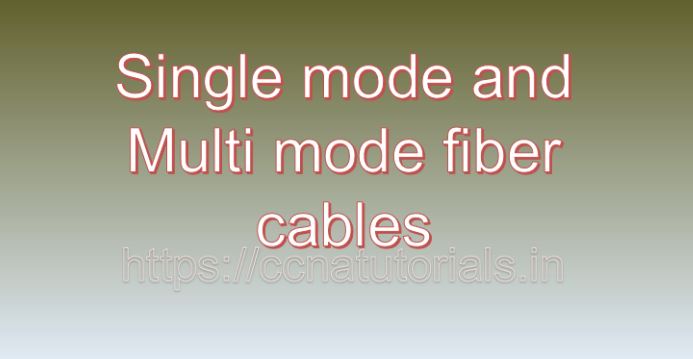Contents of this article
In this article I describe Single mode and Multi mode fiber cables used in networking for ccna. I can give you an overview of Single mode and Multi mode fiber cables used in networking for ccna, along with examples.
Single mode and multi mode fiber cables are two types of optical fiber cables used in networking to transmit data over long distances at high speeds. These cables differ in their construction, transmission characteristics, and applications, making them suitable for different types of network deployments. Let’s explore the differences between single mode and multi mode fiber cables in detail:
Single Mode Fiber (SMF):
Single mode fiber optic cables have a smaller core diameter compared to multi-mode fibers, typically around 9 microns (µm). They use a single mode of light propagation, allowing light signals to travel in a straight line through the core of the fiber with minimal dispersion. Single-mode fibers provide higher bandwidth and longer transmission distances compared to multi-mode fibers, making them suitable for long-distance communication.
Characteristics of Single Mode Fiber:
Small Core Diameter:
Single-mode fibers have a small core diameter, allowing them to transmit light signals over long distances without significant attenuation or signal loss.
Low Dispersion:
Single-mode fibers exhibit low dispersion, meaning that light signals travel in a straight line through the fiber core, minimizing signal distortion and ensuring high transmission quality.
Long Transmission Distances:
Single-mode fibers support long transmission distances, typically ranging from tens to hundreds of kilometers, making them ideal for telecommunications networks, undersea cable systems, and backbone connections between data centers.
Higher Bandwidth:
Single-mode fibers offer higher bandwidth compared to multi-mode fibers, enabling the transmission of multiple channels of data at high speeds over a single fiber.
Applications of Single Mode Fiber:
- Long-distance telecommunications networks
- Undersea cable systems
- Backbone connections between data centers
- High-speed internet connections
- Metropolitan area networks (MANs)
- High-bandwidth applications requiring low signal attenuation and dispersion
Multi Mode Fiber (MMF):
Multi mode fiber optic cables have a larger core diameter compared to single-mode fibers, typically ranging from 50 to 62.5 microns (µm). They support multiple modes of light propagation, allowing light signals to travel through the fiber core along different paths. Multi-mode fibers are suitable for short-distance transmissions within buildings or campus environments.
Characteristics of Multi Mode Fiber:
Larger Core Diameter:
Multi-mode fibers have a larger core diameter compared to single-mode fibers, allowing them to capture and transmit light signals over short distances with fewer modal dispersion effects.
Modal Dispersion:
Multi-mode fibers exhibit modal dispersion, meaning that light signals travel along multiple paths through the fiber core, resulting in signal distortion and dispersion over long distances.
Short Transmission Distances:
Multi-mode fibers are suitable for short-distance transmissions, typically ranging from hundreds of meters to a few kilometers, making them ideal for LAN (local area network) connections, campus networks, and data center interconnects.
Lower Bandwidth:
Multi-mode fibers offer lower bandwidth compared to single-mode fibers, limiting the number of channels of data that can be transmitted simultaneously over a single fiber.
Applications of Multi Mode Fiber:
- LAN (local area network) connections
- Campus networks
- Data center interconnects
- Short-distance telecommunications links
- High-speed internet connections within buildings or campuses
Conclusion for Single mode and Multi mode fiber cables
In summary, single mode and multi mode fiber optic cables offer different transmission characteristics and are suitable for different types of network deployments. Single-mode fibers are used for long-distance communication requiring high bandwidth and low signal attenuation, while multi-mode fibers are used for short-distance connections within buildings or campuses where cost-effectiveness and ease of installation are important considerations.
Understanding the differences between single-mode and multi-mode fiber cables is essential for selecting the most suitable fiber optic solution for a given networking application. I hope you found this article helpful related to Single mode and Multi mode fiber cables for ccna. You may drop a comment below or contact us for any query or suggestions related to the contents of this website.






